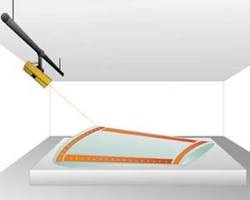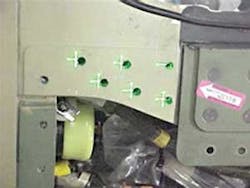Creating an image
Laser-assisted assembly using laser-imageable materials can accelerate process and quality improvements in manufacturing
Corey O’Connor, Michael King, and Scott Moroney
Computer Aided Drawing (CAD) driven laser projection technologies are beginning to replace traditional hard-templating for manufacturers in a variety of practices due to opportunities for time and cost savings along with increases in tooling and part placement accuracy. The requirements of such factors in mission-critical applications such as aerospace, which currently has the most mature adoption, are extremely high and can impact the final performance of the product. Drill-hole targets and trim-line location, part placement, and composite ply lay-up are examples of where laser projection has supplanted traditional practices.
Value has recently been added to this technique through innovations such as RegiStar laser-imageable technologies, a product that is applied to target substrates and exposed with the CAD-driven laser to create a visible mark used by operators to machine or assemble a part. Parts that once required immediate tooling can now be imaged with the laser and stored for tooling at a later time. Also, the accuracy of the laser can be significantly greater than large template-style “hard tools” as it is a mirror image of the CAD design projected onto the part.
In 3D laser projection a single beam of laser light is aimed at a specific location in 3D space and manipulated to ‘project’ an accurate pattern within a predetermined space (see Figure 1). By focusing a diode laser onto a pair of fast moving and accurate computer-controlled mirrors a visible pattern is created on a target substrate. In essence, one is able to project a CAD blueprint onto any given substrate. In Figure 2, a set of holes has been drilled using a traditional hard tooling process with the correct drill-hole locations marked by the cross hair pattern of the green laser. The traditional hard tooling process has not accurately located the holes according to the CAD data supplied in the product design. This misalignment could possibly lead to assembly errors and diminished performance capability in the final product.
532nm green lasers, with better eye visibility, are the most common type used with laser-imageable materials because this wavelength, when used in conjunction with laser-imageable materials, leaves a noticeable “mark” or pattern on the substrate, but is not powerful enough to impart any change to the substrate itself. The laser-imageable materials are specifically formulated to react with the 532nm wavelength of green lasers. To be classified as Class IIIa “eye-safe” lasers, allowing projection in an open environment, power is limited to ≤5mW.
Still, some deficiencies need to be addressed. For example, currently manufacturers are unable to decouple the laser imaging process from the fabrication process. The laser must be in position and projecting while operators perform the assembly process, where it is common for an operator’s hands to block the laser projection, losing the “blueprint” from which they are working. Rohm and Haas Electronic Materials team was asked to create a product that could give the laser projection some permanence on the substrate after the laser had finished projecting. The RegiStar line of laser imageable products accomplishes this objective.
The main technical barrier to realizing these products arises from the fact that green radiation is also available in virtually all forms of commercial lighting. The RegiStar products must be activated by low-power green laser radiation while also exhibiting a reasonable amount of ambient light stability. The tape product accomplishes this by exhibiting dual chemical interactions that produce a visible color contrast when activated.
The tape is composed of multiple layers built around a white polyester base, having on one side an acrylic adhesive covered by a non-silicone polyester release liner. The opposing side is coated with a proprietary laser-sensitive lacquer, covered by opaque black polypropylene (see Figure 3).
Green laser radiation, having a power of less than 5mW, is focused on a specific target substrate area. According to the outline produced by the laser, RegiStar tape is affixed to the substrate. When ready to mark the product, the opaque coversheet is removed and the laser begins to deliver exposing radiation. A red sensitizing dye present in the formulation accepts this radiation and transfers the energy to a redox pair, which reduces the red sensitizer to its colorless form. This produces immediate color contrast against the red film background. In the laser-exposed areas, the redox pair also reduces a photo-dissociated oxidant, rendering it unable to oxidize a colorless leuco-type dye to its colored state. Contrariwise, in unexposed areas, ambient lighting excites the photo-oxidant, which in turn oxidizes the colorless leuco-type dye to its dark, colored state further enhancing the contrast between the transparent exposed areas and darkening background.
For utility on colored substrates, the RegiStar tape product is coated on white polyester, which provides adequate hiding power over the colored substrates so that when the red sensitizing dye is bleached to produce the initial contrast, the exposure is readily visible. The opaque coversheet shields the product from activating ambient light before it’s ready for use, while also providing a re-applicable cover that can be utilized post-laser imaging to extend the contrast life of the product indefinitely.
Typical ambient light exposure will eventually darken the photo-imageable tape to a point where the image contrast disappears. Under 50fc fluorescent lighting, this process takes about 72 hours. Weaker lighting will extend the contrast life and re-application of the opaque coversheet will extend the image life of the tape indefinitely.
A second version of the laser-imageable technologies is a waterborne paint product, developed to give fabrication operators greater application flexibility on irregular surfaces as well as providing for end uses in which the tape is not suitable. It is based on a traditional latex paint formulation, with the added benefit that after the coating dries and work is performed, it can be peeled from the substrate as one continuous piece fit for standard disposal.
The latex paint base has been infused with photosensitive ingredients tailored to react with the green laser radiation by darkening only in exposed areas. This is accomplished through the incorporation of a red sensitizing dye which accepts the green radiation and transfers that energy to a photo-oxidant. The photo-oxidant oxidizes a colorless leuco-type dye to its colored configuration, providing for contrast of the dark, laser-exposed regions against the red paint background. Contrast life in this product is due to the ambient light stability of the leuco-type dye. An energy threshold overcome by the low-power laser and not the green radiation in ambient lighting provides for this differentiation. Pigment fillers are included in the formulation to give the product acceptable hiding power over darker colored substrates.
One end use for the photo-imageable paint is paint masking where the paint would first be applied to a target substrate area to be painted. The paint design outline is then projected onto the RegiStar paint, creating a visible outline. Along this outline, the paint is scored and the target area is peeled from the substrate. A final paint coating is then applied over the remaining mask, and finally the mask is removed leaving the intended paint design. An example of this application would be the logos emblazoned on an aircraft tail.
The use of lasers in manufacturing is growing through the integration of CAD data, laser placement systems, and laser-imageable materials. Through its initial adoption in aeronautic applications, laser-assisted assembly is proving to be an accelerator of process and quality improvements in manufacturing environments. Future challenges include adoption in additional industries and the continued advances in materials, process, and equipment technologies. The construction and warehousing of large-scale hard tools may soon be merely a memory in the fabrication of products such as airplanes, ships, and pre-fabricated housing. Manufacturing technologies are advancing quickly to meet the need of designers and fabricators to find an edge among competitors. We’re betting laser-assisted assembly can be a part of the solution.
Corey M. O’Connor ([email protected]) is a chemist in New Platforms Research and Development, Michael King ([email protected]) is a business development manager for the Circuit Board Technologies division, and Scott Moroney is marketing communication manager for the Circuit Board Technologies division, all at Rohm and Haas.



